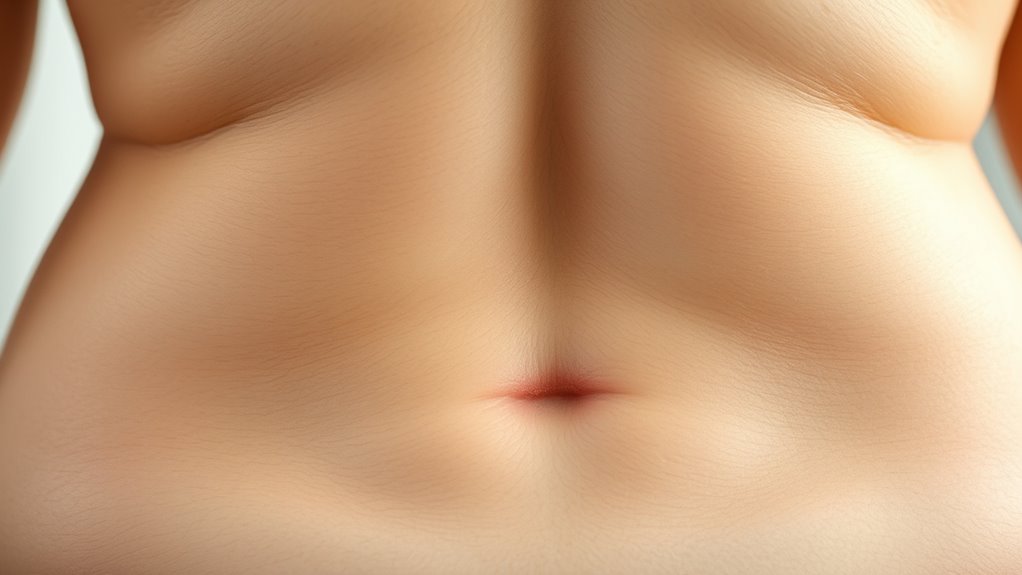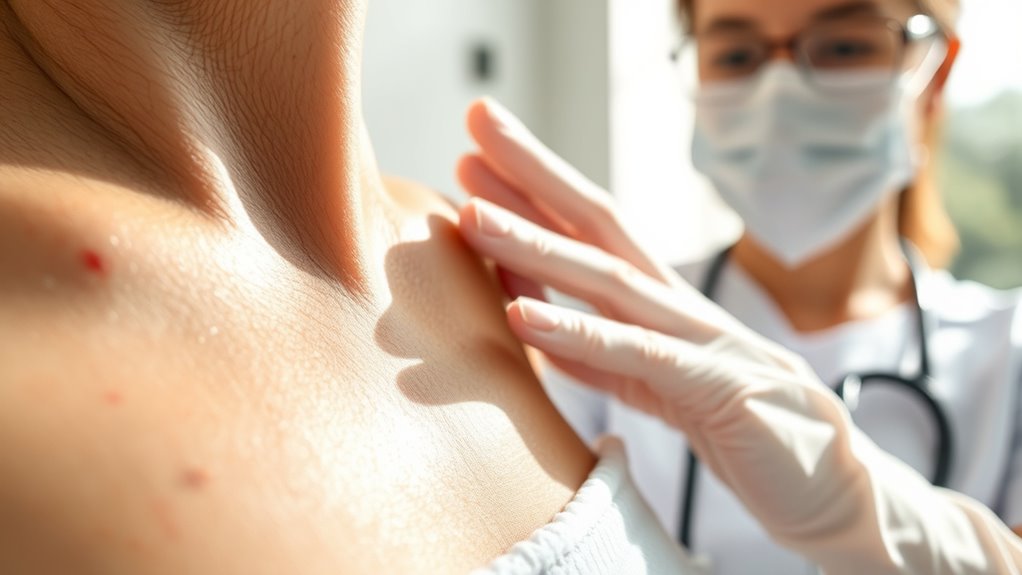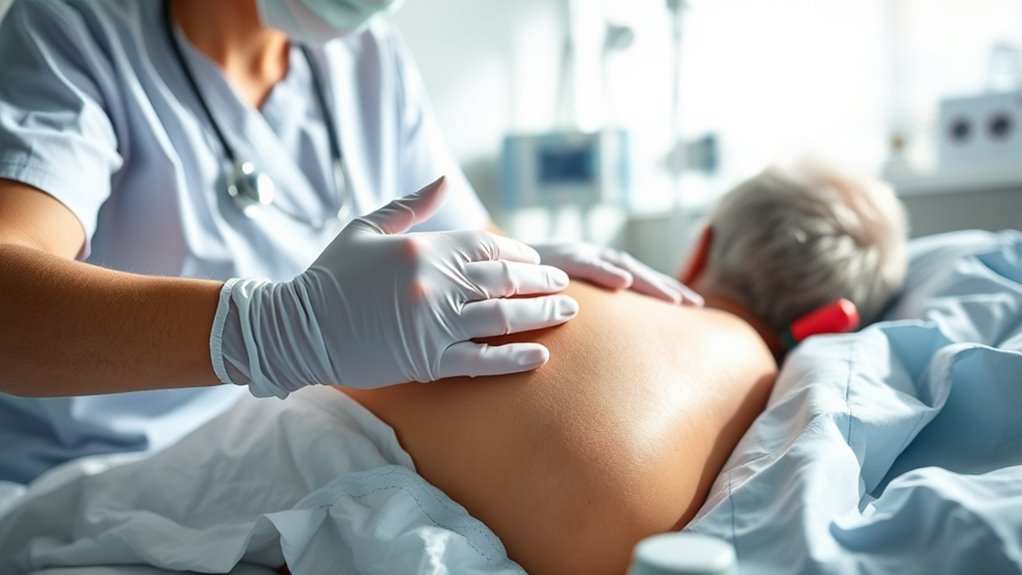To avoid pitfalls in pressure sore prevention, you should regularly reposition and shift to relieve pressure, perform routine skin inspections to catch early signs of damage, and make certain you’re using appropriate support surfaces like modern mattresses. Don’t overlook proper nutrition and hydration, as they help keep skin healthy and promote healing. Finally, educate caregivers and patients so everyone understands and follows best practices. Keep going, and you’ll uncover even more strategies to protect skin health.
Key Takeaways
- Establish a consistent repositioning schedule and use automation to ensure regular pressure relief.
- Conduct daily skin inspections, especially over bony prominences, to detect early signs of damage.
- Use modern, pressure-redistributing support surfaces and mattresses suited to individual needs.
- Maintain proper nutrition and hydration to support skin health and promote healing.
- Educate caregivers and patients on prevention strategies, including repositioning, skin checks, and proper support use.
Neglecting Regular Repositioning and Shifting

Neglecting to regularly reposition and shift a patient can quickly lead to the development of pressure sores. To prevent this, establishing consistent repositioning schedules is essential. These schedules ensure you change the patient’s position often enough to relieve pressure on vulnerable areas. Alongside scheduled shifts, using skin assessment techniques helps identify early signs of pressure damage. Regularly inspecting the skin allows you to catch redness, swelling, or breakdown before they worsen. By combining timely repositioning with careful skin assessments, you reduce the risk of pressure sores substantially. Incorporating robotics and automation can also improve the efficiency and consistency of repositioning practices. Remember, each patient’s needs vary, so tailor your schedule accordingly. Staying vigilant with repositioning and skin checks is your best defense against pressure ulcer formation and ensures patient comfort and safety.
Ignoring Skin Inspection and Early Signs of Damage

Failing to regularly inspect the skin and recognize early signs of damage can quickly lead to pressure sore development. A thorough skin assessment helps you catch redness, warmth, or skin changes before they worsen. Early detection is crucial, as it allows you to intervene promptly and prevent a small irritation from turning into a serious sore. Skipping routine inspections increases the risk of missing subtle signs of damage, especially in difficult-to-see areas. Make it a habit to check the skin at least daily, paying close attention to bony prominences and high-risk zones. Incorporating air quality awareness into your routine can help identify environmental factors that may affect skin health, further reducing the risk of pressure sore progression. By staying vigilant and recognizing early signs, you can take immediate action—relieving pressure and improving skin condition—ultimately reducing the chances of pressure sore progression.
Using Inadequate Support Surfaces and Mattresses

Using inadequate support surfaces and mattresses can undermine your efforts to prevent pressure sores, even if you’re diligent with skin inspections. Support surface selection is essential because it affects pressure distribution and reduces friction. Choosing the right mattress technology ensures that pressure points are relieved and moisture is managed effectively. An outdated or inappropriate mattress can lead to persistent pressure, increasing the risk of skin breakdown. Modern support surfaces, like pressure redistribution mattresses or foam overlays, are designed to adapt to body contours and reduce shear forces. Investing in the correct mattress technology tailored to your needs isn’t just comfort—it’s a critical preventative measure. Proper support surfaces help maintain skin integrity, making your pressure sore prevention strategy more effective and sustainable. Additionally, selecting appropriate materials can enhance durability and hygiene, further supporting skin health.
Overlooking Proper Nutrition and Hydration

Proper nutrition and hydration play a essential role in maintaining healthy skin and preventing pressure sores. Without adequate intake of nutrients, your body faces nutritional deficiencies that impair skin integrity and slow healing. Proper hydration management ensures your tissues stay supple and resilient, reducing the risk of breakdown. To optimize skin health, focus on:
Proper nutrition and hydration are vital for healthy skin and pressure sore prevention.
- Assuring a balanced diet rich in protein, vitamins, and minerals
- Regularly monitoring hydration levels to prevent dehydration
- Addressing nutritional deficiencies promptly through dietary adjustments or supplements
Additionally, utilizing appropriate water filtration systems can help remove contaminants that may negatively impact skin health and overall well-being. Neglecting these aspects can lead to weakened skin, delayed wound healing, and increased pressure sore risk. Maintaining proper nutrition and hydration isn’t just about overall health—it’s a critical component of pressure sore prevention, keeping your skin strong and resilient against injury.
Failing to Educate Caregivers and Patients About Prevention

When caregivers and patients lack proper education about pressure sore prevention, important practices may be overlooked, increasing the risk of injury. Without adequate caregiver training and patient empowerment, essential steps like regular repositioning, skin inspection, and maintaining good hygiene can fall through the cracks. Educating both parties ensures they understand the importance of pressure relief and skin care, reducing preventable wounds. When patients are empowered with knowledge, they become active participants in their own care, making it easier to follow prevention strategies. Clear communication and ongoing education build confidence, encouraging consistent adherence to best practices. Additionally, effective communication between caregivers and patients fosters trust and reinforces the importance of pressure sore prevention. Ultimately, prioritizing education helps create a proactive environment where pressure ulcers are less likely to develop, safeguarding health and improving quality of life.
Frequently Asked Questions
How Can Technology Assist in Pressure Sore Prevention?
Technology helps you prevent pressure sores by using pressure sensors to monitor your skin constantly. These sensors detect early signs of pressure buildup, alerting you or caregivers to shift position before sores develop. Remote monitoring allows healthcare providers to track your skin health in real-time, providing timely interventions. This proactive approach reduces the risk of pressure ulcers, ensuring your comfort and promoting faster healing if issues arise.
What Role Do Mobility Exercises Play in Prevention?
You might think mobility exercises are optional, but they’re essential for pressure sore prevention. By engaging in muscle strengthening and flexibility routines, you improve circulation and reduce pressure points. These exercises help maintain skin integrity and prevent tissue breakdown, especially for those with limited mobility. Incorporate regular movement to keep your skin healthy and resilient, ultimately lowering your risk of developing pressure sores.
Are There Specific Skin Care Products Recommended?
You should use moisturizing creams and barrier ointments to protect your skin. Choose products that hydrate without causing irritation, and barrier ointments to create a protective layer against moisture and friction. Regularly applying these helps maintain skin integrity, especially in areas prone to pressure sores. Make sure to select products suitable for sensitive skin and apply them consistently to keep your skin healthy and resilient.
How Do Underlying Health Conditions Affect Pressure Sore Risk?
Your underlying health conditions, like chronic illnesses, can increase your pressure sore risk by weakening your skin and impairing healing. Managing these conditions through proper chronic illness management is vital. Additionally, maintaining good nutritional support helps strengthen your skin and boosts your body’s ability to recover. Regular monitoring and tailored care plans can greatly reduce your risk, ensuring better pressure sore prevention and overall health.
What Are the Latest Advances in Pressure-Relieving Devices?
You might think traditional foam cushions are enough, but recent advances prove otherwise. Pressure mapping technology now helps customize pressure-relieving devices, ensuring ideal support. High-tech foam cushions adapt to your body’s unique shape, reducing risk even further. These innovations mean you get personalized comfort and protection, turning what once was basic into smarter, more effective solutions that actually prevent pressure sores. Who knew technology could make such a difference?
Conclusion
By staying vigilant and proactive, you can prevent pressure sores before they start. Think of your skin as a delicate garden—regular care, proper support, and education are the watering can and sunlight it needs to flourish. Don’t wait for trouble to knock; instead, take these simple steps to keep your skin healthy and strong. Remember, prevention is your best armor against the pain and complications of pressure sores.









